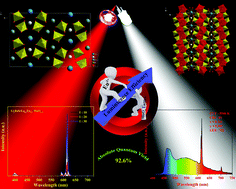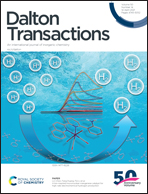Narrow-band red-emitting phosphor with negligible concentration quenching for hybrid white LEDs and plant growth applications†
Abstract
Narrow-band red-emitters are the key to solving problems encountered by the current white LED technology. In this context, a series of new red-emitting Li3BaSrLa3(MoO4)8:Eu3+ phosphors were synthesized and characterized through various spectroscopic methods. All phosphor compositions were crystallized in the monoclinic phase, with space group C2/c. A broad charge transfer (O2− → Mo6+) extended up to the blue region along with strong 7F0 → 5L6, 5D3 absorption, making them looked-for materials for warm white LED applications. The concentration quenching study reveals that there was no concentration-quenching occuring and the quantum yield of this non-concentration-quenching Li3BaSrLa0.3Eu2.7(MoO4)8 phosphor reaches 92.6%. The Li3BaSrLa0.3Eu2.7(MoO4)8 retain >80% of its emission intensity at 150 °C. The best red-emitting composition was integrated with near UV LED and obtained bright red emission with CIE x = 0.6647, y = 0.3357. White LED was fabricated by integrating the blue LED with yellow dye + red phosphor and white LED showed bright white light with CCT (5546 K), CIE (0.331, 0.385), and CRI (81%). In addition, the red LED spectrum is well-matched with the phytochrome (Pr) absorption spectrum and is useful for plant growth applications.



 Please wait while we load your content...
Please wait while we load your content...